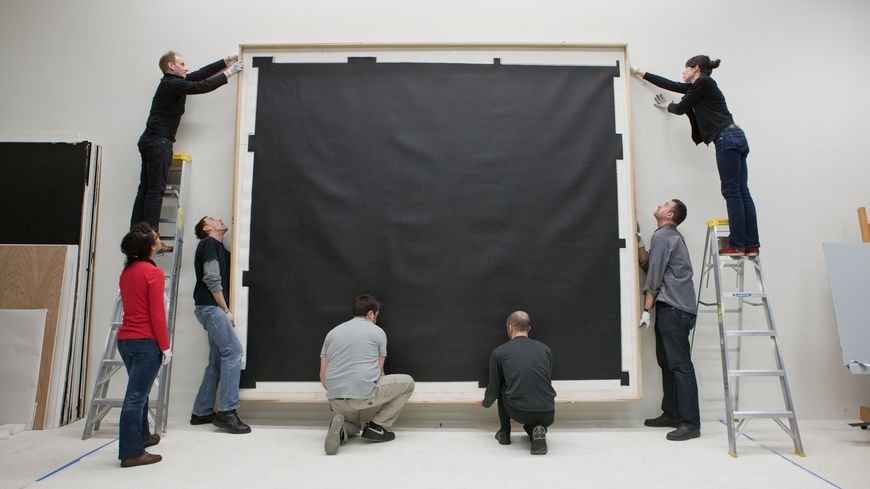Sally Grant
Art Historian. Curator. Writer.
Simon Fujiwara, Around and Around Who Goes?, Colored paper collage, pastel, 2022.
“What's Old Was New at Frieze New York”
Essay for Arthur (askarthur.art), May 2022
Following the whirlwind of Frieze New York, as galleries pack up to head home, there’s time to reflect on the subtleties of the fair’s highlights. In an article published on May 11, Frieze noted we would see a “Rethinking of Art History at Frieze New York 2022.” In fact, this engagement with art of the past extended even further than described. Direct citations of historical artworks resulted in a number of new images that are culturally vital and artistically garden-fresh. …
Kholod Hawash, Intimacy, hand-sewn fabric, 2021.
“What to See at Frieze New York”
Preview for Arthur (askarthur.art), May 2022
Returning to New York for its tenth year—with new director Christine Messineo—Frieze opens this week in The Shed. It’s the art fair’s second year in this venue after eight editions on Randall’s Island. Featuring over 65 leading galleries, Frieze New York is an exhilarating way to keep abreast of the global art market. There’s so much to see, but where to start? …
“Winter Garden”
Essay for Arthur (askarthur.art), May 2022
“Black are my steps on silver sod; Thick blows my frosty breath abroad; And tree and house, and hill and lake, Are frosted like a wedding cake.” (Robert Louis Stevenson, “Winter-Time”)
At the close of winter, this Collection is for those enchanted by snow. …
“How Does Art Travel?”
Blog post for the Guggenheim, New York, April 2022
For the exhibition Vasily Kandinsky: Around the Circle, Peter Mallo, the Guggenheim’s Chief of Frame Production and Development, needed to design a frame for a small painting titled Calm. Dating to 1926, Kandinsky’s work, comprising oil on wood panel, was unframed and had been exhibited rarely in recent decades. Its inclusion in the exhibition required it to be suitably protected, transported, and displayed, a process central to what Mallo called the ongoing “lives of paintings.”
While traveling for exhibitions may reinvigorate the life of a work—placed in a different context it is seen anew, and by new people—traveling itself brings complication.
…
So how does the art travel to and from an exhibition?
“The ultimate symbol for our times”
Essay for BBC Culture, June 2021
For centuries, the window has been used by artists to help make sense of the world – and it's a potent symbol that resonates ever more strongly today, writes Sally Grant.
In View from the Artist's Window (1978), the US painter Alice Neel captured an image familiar to New Yorkers (and other city-dwellers): that of the apartment building across from their own. For Neel, who is the subject of a retrospective currently at the Metropolitan Museum of Art, such scenes of New York City life drove her art. As she said of the space that was both her home and her studio, "I really live out my front room windows, which face up Broadway from 107th Street. It's like having a street in your living room". With this comment, and this painting, Neel highlighted a motif that has long captivated artists – the view through a window to the outside world.
Wu Tsang, Anthem (working title), 2021.
“Space Reimagined: Collective Individualism and Individual Collectivism in the Rotunda”
Blog post for the Guggenheim, New York, March 2021
Re/Projections: Video, Film, and Performance for the Rotunda marks a significant moment in the Guggenheim’s history. Opening just over a year since the museum closed its doors due to COVID-19, this series of four projects responds to our current time of social unease, political unrest, and cultural reckoning, while also galvanizing the museum to reconsider the institutional practices that have informed its collection and exhibitions to date.
And, after a prolonged period of isolation, Re/Projections offers an environment in which to gradually, thoughtfully, reconvene. …
“The Brodie set: Muriel Spark’s "The Prime of Miss Jean Brodie"' by Sally Grant”
Essay for the Australian Book Review, June-July 2018, no. 402
I don’t remember how old I was when I first saw the film version of The Prime of Miss Jean Brodie. As a young girl growing up in north-east Scotland, I didn’t know that it had been adapted from a 1961 novel of the same name by a writer known for her keen observational skills and biting wit called Muriel Spark, or that the story had first appeared, almost word for word, in the pages of The New Yorker. Indeed, I highly doubt I had heard of that august publication, let alone understood the writerly prestige of having an issue of The New Yorker devoted to one story.
But I do remember that when the indomitable schoolteacher Miss Brodie, as channelled by the equally formidable Maggie Smith, said this to her pupils, in her distinctive Edinburgh burr, I was smitten: … “Little girls, I am in the business of putting old heads on young shoulders, and all my pupils are the crème de la crème. Give me a girl at an impressionable age, and she is mine for life.”






